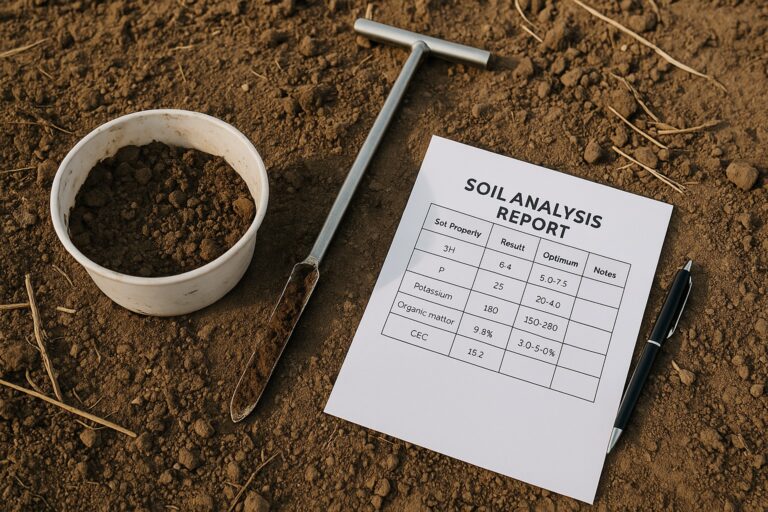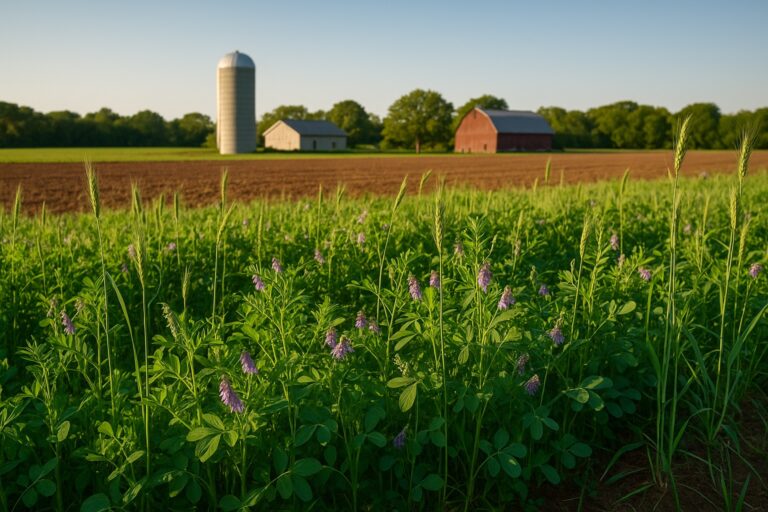Anúncios
Sustainable land management is more than a trend—it’s a necessity for those who depend on the soil for their livelihood. From small rural farms to large-scale agricultural operations, the way we treat the land today will determine its productivity tomorrow. Managing the land responsibly means caring for its health, preserving its biodiversity, and maintaining its economic value over time.
Farmers, agronomists, and land managers across the United States are increasingly turning to sustainable practices. These methods are designed not only to improve soil and crop health but also to reduce dependence on chemical inputs, improve water retention, and safeguard surrounding ecosystems. Sustainability, in this context, is both an environmental and economic strategy.
If you’re looking for practical, proven strategies to manage your land more sustainably, this guide was made for you. We’ll walk through the key techniques that can help you maintain productivity while protecting the long-term health of your soil and environment—without buzzwords or empty promises. Let’s dig into the essentials of sustainable land management.
Understanding sustainable land management
Sustainable land management (SLM) refers to a set of practices that ensure the use of land resources in a way that meets current human needs without compromising the ability of future generations to meet theirs. It’s a holistic approach that balances environmental protection, economic viability, and social responsibility.
At its core, SLM focuses on maintaining and enhancing the productivity of land while minimizing degradation. This involves understanding natural systems—soil, water, plants, and climate—and working with them rather than against them. For U.S. farmers and land managers, this might mean adapting practices based on local rainfall patterns, soil types, or native vegetation.
Implementing SLM does not require abandoning productivity goals. On the contrary, many sustainable practices lead to better yields over time. By investing in the land’s health, you’re investing in your farm’s resilience and profitability.
Importance of preserving soil health
Soil is the foundation of all agriculture. Healthy soil retains water, cycles nutrients, supports plant roots, and plays a crucial role in carbon sequestration. Yet, it’s also one of the most overlooked resources in farming.
Years of intensive farming, tilling, and chemical use have degraded large areas of American farmland. Erosion, compaction, nutrient loss, and declining organic matter are common issues. To reverse this, producers are shifting toward soil-first strategies.
These include reducing or eliminating tillage, increasing organic matter, using compost or manure, and growing soil-protective plants like grasses and legumes. A living, biologically active soil is more productive, less dependent on external inputs, and better able to resist droughts and pests.
Crop rotation and diversification strategies
One of the simplest and most effective ways to improve land sustainability is through crop rotation. This means alternating different crops in a specific sequence on the same field to prevent nutrient depletion and interrupt pest cycles.
For example, rotating corn with soybeans or legumes can improve nitrogen levels naturally. Adding a third or fourth crop—like oats, sorghum, or alfalfa—can further enhance soil health and reduce disease risks. Diversified rotations improve root structures, support microbial activity, and create a more stable farming system overall.
In addition to rotation, polyculture—growing multiple crops in the same space—can increase land productivity while reducing weed and insect pressure. Even small changes in planting patterns can make a big difference in sustainability outcomes.
Cover crops and organic matter enrichment
Cover crops are non-cash crops planted during the off-season to protect and nourish the soil. They include rye, clover, radish, and vetch, among others. These crops serve multiple functions: reducing erosion, suppressing weeds, fixing nitrogen, and adding biomass to the soil.
When cover crops decompose, they enrich the soil with organic matter—improving structure, water retention, and nutrient availability. Some, like daikon radish, even help break up compacted soil layers, allowing for deeper root penetration.
The key is selecting the right cover crop mix for your region and timing the planting and termination correctly. Many U.S. farmers have successfully incorporated covers into corn and soybean rotations with measurable gains in soil fertility and moisture retention.
Water conservation techniques for drylands
In arid and semi-arid regions of the U.S., especially the Southwest, water is the most limiting resource. Managing it wisely is essential not only for crops but for long-term land sustainability.
Techniques like drip irrigation, contour farming, mulching, and water harvesting can make a significant impact. Drip irrigation delivers water directly to plant roots, reducing evaporation. Mulch—whether organic or plastic—helps keep soil moisture stable and suppresses weed growth.
Another method, keyline design, involves shaping land contours to slow water runoff and encourage infiltration. Rainwater catchment systems and cisterns are becoming popular in small farms as a way to supplement water supply.
Efficient water use also involves selecting drought-resistant crop varieties and adjusting planting schedules to align with natural rainfall.
Responsible use of fertilizers and pesticides
Chemical inputs can boost yields—but they also come with environmental costs when overused or mismanaged. Nutrient runoff contributes to water pollution, while pesticide overuse can harm pollinators and beneficial soil microbes.
Sustainable land managers aim to optimize, not eliminate, inputs. Soil testing should guide fertilizer application to prevent excess. Precision agriculture tools—like GPS-guided spreaders and drones—help apply the right amount, at the right place, and at the right time.
For pest management, integrated pest management (IPM) is a preferred approach. IPM combines biological controls, crop rotation, and habitat manipulation to keep pests in check while minimizing chemical use. Long-term, this reduces resistance development and improves farm ecosystems.
Agroforestry and integrated land use
Agroforestry blends trees and shrubs with crops or livestock to create more resilient and diverse land systems. Trees provide shade, windbreaks, erosion control, and additional income through fruit, nuts, or timber.
Popular agroforestry practices in the U.S. include alley cropping (planting crops between tree rows), silvopasture (combining livestock and trees), and riparian buffers (vegetated areas along waterways). These systems offer ecological and economic benefits.
Beyond production, trees also enhance biodiversity and support wildlife corridors. They stabilize the landscape, reduce runoff, and can even help sequester carbon—a key factor in fighting climate change.
Technological tools for sustainable management
Technology plays a crucial role in advancing sustainable land use. Today’s farmers have access to a range of digital tools that allow for better decision-making and resource management.
Soil sensors can provide real-time data on moisture and nutrients. Drones help monitor crop health and map problem areas. Satellite imagery and GIS software support long-term planning and environmental monitoring.
Decision-support apps offer alerts, recommendations, and field-specific insights. For example, the USDA’s NRCS Web Soil Survey and tools like AgFiniti and Climate FieldView help optimize inputs while tracking environmental impact.
Technology should not replace good practices—but it can make them more effective, especially when paired with traditional knowledge.
Community engagement and knowledge sharing
Sustainability is not a solo journey. One of the most powerful accelerators of change is the sharing of knowledge among farmers, researchers, and local communities.
Joining or forming producer networks, participating in field days, and attending extension workshops can expose land managers to new ideas and peer-tested solutions. In many areas, conservation districts and NRCS field offices offer technical assistance and cost-sharing programs for sustainable practices.
Online platforms like AgTalk, Reddit farming communities, and university agricultural extensions are great sources of practical advice. The more farmers collaborate, the faster sustainable land management practices spread and evolve.
Working together strengthens community resilience and empowers producers to adopt changes with confidence.
Conclusion
Sustainable land management is not about doing less—it’s about doing better. For today’s farmers, agronomists, and landowners, the goal is to build systems that produce abundantly while preserving the earth’s ability to do so in the future.
From soil health to water conservation, crop diversity to agroforestry, the strategies are already available. What’s needed is the will to implement them, one field at a time.
Whether you’re just starting your journey or looking to deepen your efforts, now is the right time to adopt sustainable land practices. Your land—and the generations to come—will thank you for it.
Frequently Asked Questions
1. What are the main goals of sustainable land management?
To maintain land productivity, reduce degradation, preserve biodiversity, and support rural livelihoods through eco-friendly farming methods.
2. How can I start improving soil health on a small farm?
Begin by reducing tillage, adding organic matter like compost, and using cover crops to protect and enrich your soil.
3. Are sustainable practices more expensive?
Some require upfront investment, but many result in long-term savings through reduced input use and better yields. Government programs can also help fund transitions.
4. Can technology really make a difference in sustainability?
Yes. Tools like soil sensors, drones, and decision apps help you use resources more efficiently and spot problems early, saving time and money.
5. Where can I learn more about these techniques in my region?
Check with your local USDA NRCS office, university extension program, or join a farmer-led sustainability network for region-specific guidance.



